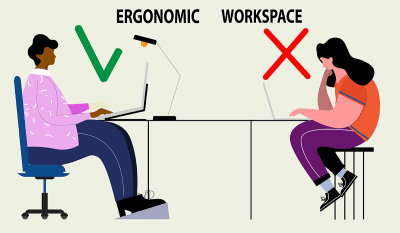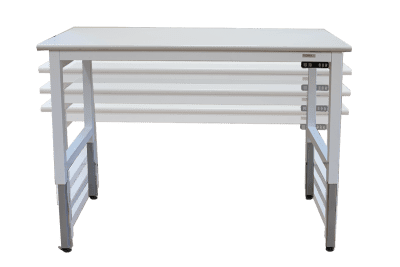Several years ago we published a blog article discussing workplace ergonomics and why it’s important. However, that post was written in pre-pandemic days, and much has changed since then. When COVID hit, a significant portion of the world’s workforce became comfortable with and accustomed to sitting at home on their couches, kitchen tables, or worse their beds, to do remote-based work. Now that the pandemic is finally moving behind us, businesses are recalling employees to the workplace. While this is good news, because certainly sitting on the couch all day is not good ergonomics, the adjustment to a lifestyle away from pajama bottoms and streaming TV is not an easy one to embrace.

In our fast-paced world, work occupies a significant portion of our lives. Creating a comfortable and healthy work environment should be your number one goal as a business owner, especially post-pandemic.
A BRIEF HISTORY OF ERGONOMICS
Ergonomics, derived from the Greek words “ergon” (work) and “nomos” (laws), is the science of designing and arranging the workplace to fit the worker’s needs. This concept has been around for much of recorded human history, and it gained traction during World War II when interactions between humans and machines became more complex. Ergonomics aims to prevent injuries and discomfort while promoting efficiency and overall well-being.
THE IMPORTANCE OF ERGONOMICS IN THE WORKPLACE
Good ergonomic practices have several benefits for both individuals and organizations:
- Enhanced Productivity: Ergonomically designed workspaces and tools reduce physical strain and discomfort, allowing employees to work more efficiently and with fewer distractions. This can lead to increased productivity and improved job satisfaction.
- Reduced Risk of Injury: Poor ergonomics can result in musculoskeletal disorders (MSDs) such as carpal tunnel syndrome, back pain, and repetitive strain injuries. By addressing ergonomics, employers can reduce the risk of these injuries, lowering healthcare costs and absenteeism.
- Employee Retention and Satisfaction: Providing a comfortable and safe work environment demonstrates a commitment to employee well-being. This can boost employee morale, reduce turnover, and attract top talent.
- Compliance with Regulations: Many countries have established ergonomics standards and regulations to protect workers. Adhering to these guidelines ensures legal compliance and avoids potential penalties.
Practical Ergonomic Tips for the Workplace
Implementing good ergonomic practices starts with simple changes that can make a big difference in how your workers feel and the quality of the work they produce:
- Proper Desk and Chair Setup:
- Adjust the chair height so that feet are flat on the floor and knees are at a 90-degree angle.
- Maintain a neutral posture with a straight back and relaxed shoulders.
- Ensure that the computer monitor is at eye level to reduce neck strain.
- Use an ergonomic keyboard and mouse to minimize wrist and hand strain.
- Monitor and Lighting:
- Position the monitor at arm’s length to reduce eye strain and glare.
- Adjust screen brightness and contrast to suit ambient lighting conditions.
- Use task lighting to reduce glare and shadows on the work surface.
- Keyboard and Mouse:
- Choose an ergonomic keyboard and mouse that fit your hand comfortably.
- Keep wrists in a neutral position to prevent carpal tunnel syndrome.
- Take regular breaks to stretch and rest your hands and wrist
- Organize Workspace:
- Keep frequently used items within arm’s reach to minimize stretching and reaching.
- Use adjustable monitor stands and document holders to maintain a clutter-free workspace.
- Sit-Stand Workstations:
- Consider sit-stand desks, like our automated height adjustable workstations, that allow you to alternate between sitting and standing throughout the day.
- Use anti-fatigue mats to reduce pressure on your legs and feet when standing.
- Breaks and Stretching:
- Take short breaks every hour to stand, stretch, and walk around.
- Perform simple stretching exercises to relax muscles and improve circulation.
- Training and Education:
- Provide employees with ergonomics training to raise awareness and encourage proper practices.
- Offer resources such as ergonomic assessments and consultations.


EMBRACE ERGONOMICS: YOUR PATH TO A HEALTHIER, MORE PRODUCTIVE WORKPLACE
Ergonomics in the workplace is not just a trend; it’s a vital component of creating a productive and healthy work environment. By investing in ergonomic principles and practices, employers can reduce the risk of injuries, enhance employee well-being, and boost overall productivity. In the long run, a commitment to ergonomics benefits both the employees and employers, leading to a happier, more efficient, and healthier workforce. So, as we transition back to the workplace post-pandemic, remember that ergonomics still matter.

